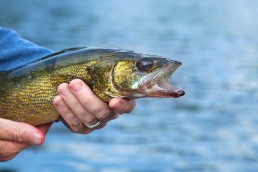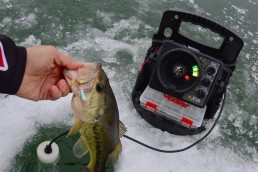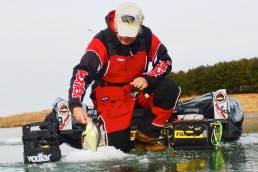Ice Fishing Safety Devices Could Save Your Life
SHARE THIS POST
John Hurt, our contact at Croegaert’s Great Outdoors in Rock Island, Ill., supplies all of our fishing information for Rock
Island in the Quad Cities and Beyond column. He is an avid fisherman year-‘round, and has designed a couple of do-it-
yourself life-saving devices for ice fishermen.
For you, they could mean the difference between crawling out of the water, or floating under it and dying. Both are simple
to build. The first, worn on your person, is with you constantly. The second, larger and kept attached to your person, is a
little more cumbersome, but both will save your life should the ice collapse under you.
Lifesaver #1: Safety picks
These are simple, easy to make and wear. They are worn much like the mittens on a string from early childhood. They are
made by cutting two pieces of one-inch dowel a couple of inches longer than the width of your palm. For instance, my
palm measures slightly over 3 1/2 inches across at the base of my fingers. I cut my dowel lengths 6 inches long.
In one end of each dowel, screw a large wood screw in about 1/2- to 3/4-inch. Cut off the head of the screw, leaving at
least a 1-1/2-inch or longer projection that you can use to jab into the ice. At the other end of the dowel, screw in a heavy
I-bolt. Then, using heavy braided line, cord or shock cord, measure with your arms fully extended from one palm up the
arm across the back, down the other arm, to the palm, adding about a foot for slack and knots. It is easy to shorten this
tether once you try it on for size. Tie a dowel on either end of the line, through the I-bolts. You now have something that
looks like a home-made jump rope, with grips and sharp ice grippers on the ends.
Thread one end through the sleeves of your ice fishing outer jacket, much like a child’s mitten on a cord. While you fish,
these should dangle from your sleeves. Should the ice break, these grabbers are there to claw into the ice, and help you
escape from the hole.
The method you use if you go through the ice is almost as important as wearing them:
As you go through, think survival, and take in a huge gulp of air. This will increase your flotation. By extending your arms
out wide on both sides, you quickly make yourself bigger than the hole, helping hold your upper body and head out of the
water. Let your air out very slowly, and begin kicking like you were swimming. This will bring your legs up under the ice,
with your upper body and head out of the water.
Keeping your head out of the water, wait a few seconds, letting your body and brain acclimate to the initial shock of going
through, and to the icy cold of the water. Orient your body so both arms will be pulling in the same general direction. One
at a time, bring the picks down hard onto the ice surface, so they catch in the ice. Then begin using your arms and picks
to crawl your way out of the hole.
You will be wet and cold, but you will be above the ice and escaping the water. Forget your gear; get to your car or shelter
as quickly as possible. Hypothermia sets in very fast. Your only object needs to be to get warm and dry.
Are you enjoying this post?
You can be among the first to get the latest info on where to go, what to use and how to use it!
Lifesaver #2: “ladder”
John’s second lifesaver is somewhat like the old fire department-type, single-pole ladders with rungs attached at the
middle, and extending out on either side of the pole. It is intended for those ice fishermen who normally fish shallower
water. If they fall through, they can anchor the “ladder” in the bottom, and climb out and over the ice. In deeper water, it
can be laid across the hole, to distribute the weight, and then you pull yourself out. It could also be used as an extension
to distribute the weight for someone trying to climb out when the ice is crumbling at the edges of the hole, and someone
crawling out to assist them would only add to the problem.
You will need a couple of good 2 x 4’s for this project. One needs to be at least 5 feet long. Keep in mind that you will be
dragging this with you to your ice fishing spot, so each foot, while it offers added protection, also adds to the weight you
pull across the ice.
Cut the second 2 x 4 into strips 5 to 6 inches long. Attach these at one-foot intervals across the pole, with the length of the
longer 2 x 4 creating something like a single-pole ladder. Attach a screen door handle to one end to use for carrying, and
attach a rope or even a bungie cord to drag it behind you across the ice. Keep it attached to your outerwear or belted
around your waist.
These are most effective for those who regularly fish in shallower water, 5 feet or less. If the ice breaks, you can then
maneuver it into the hole, lodge it in the bottom and walk up and out of the water; or you can use the length of the 2 x 4 to
span the hole and pull yourself up and out of the water.
If you think that you really don’t need a safety device in shallow water, think again.
The current and/or undertow added to
the weight of your water-soaked heavy clothing will pull you under the ice regardless of depth. This “ladder” is
cumbersome to pull in, and restricts your on-ice movements a bit, but it can be used in a number of ways in ice rescue for
yourself and others—especially in spots where the ice has thinned and weakened. If you regularly fish small farm ponds, it
might be a good idea to make one of these just for that pond. It would be there, ready for use each time, without hauling it
in and out.
Many ice fishermen fish alone. If you do, you need one or both of these simple and inexpensive-to-build devices.
Remember, the life you save could be your own!
MWO
SHARE THIS POST
Did you enjoy this post?
You can be among the first to get the latest info on where to go, what to use and how to use it!
Bess Pierce
Before Dick and Bess Pierce married, they fished. When he was laid off, they set 1000-hook jump lines, daily, to pay bills. They’ve fished rivers and the Great Lakes with children and grandchildren. From a lifetime of experiences, Bess Pierce writes basic how-tos, where-tos and the joy of the Midwest, with an emphasis on outdoor experiences for families. She may be contacted at gemini2624@aol.com.



